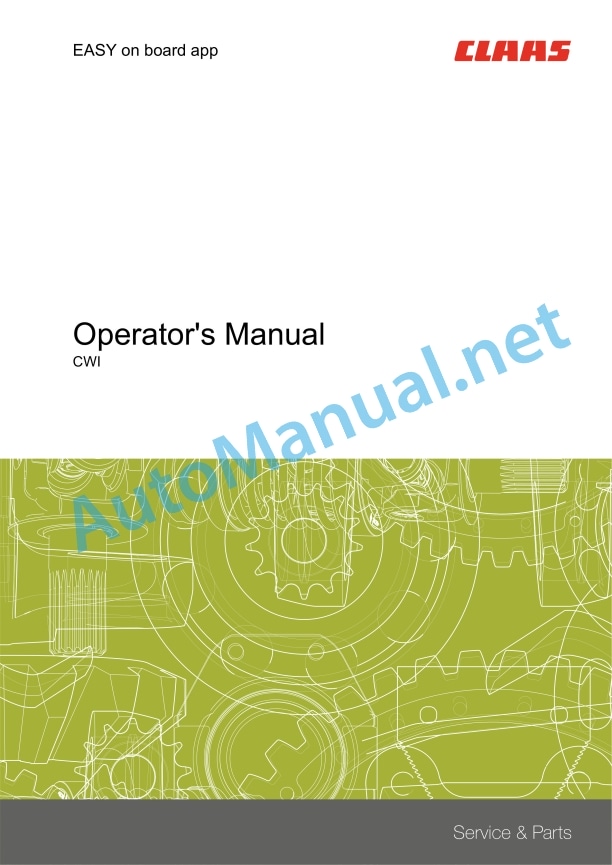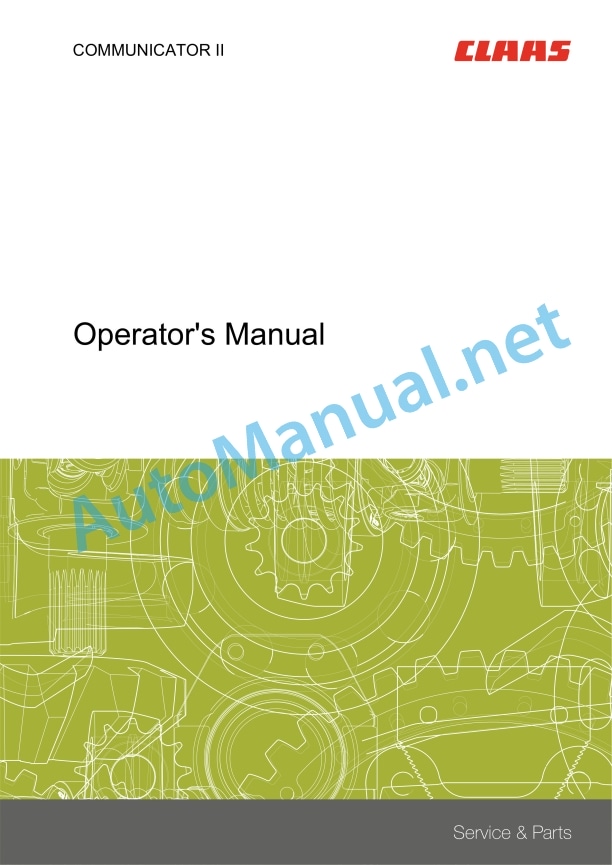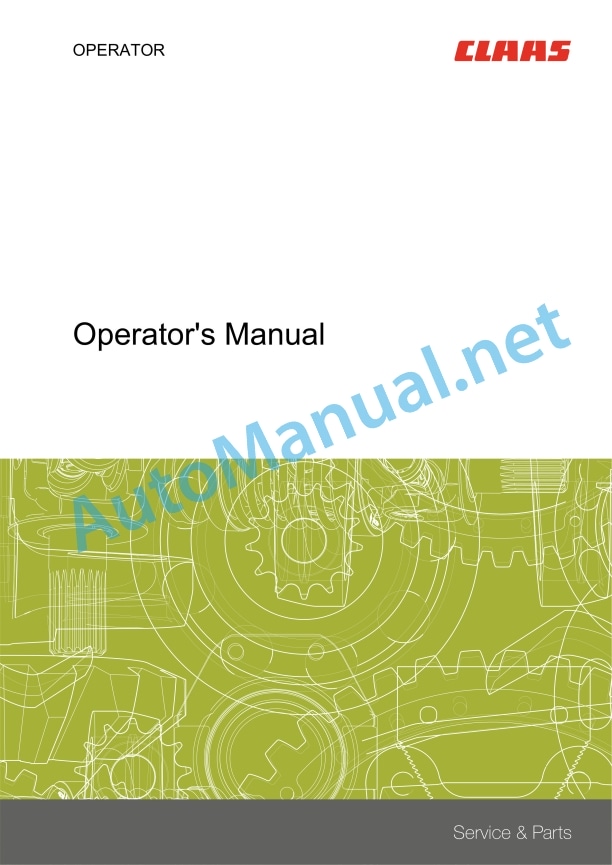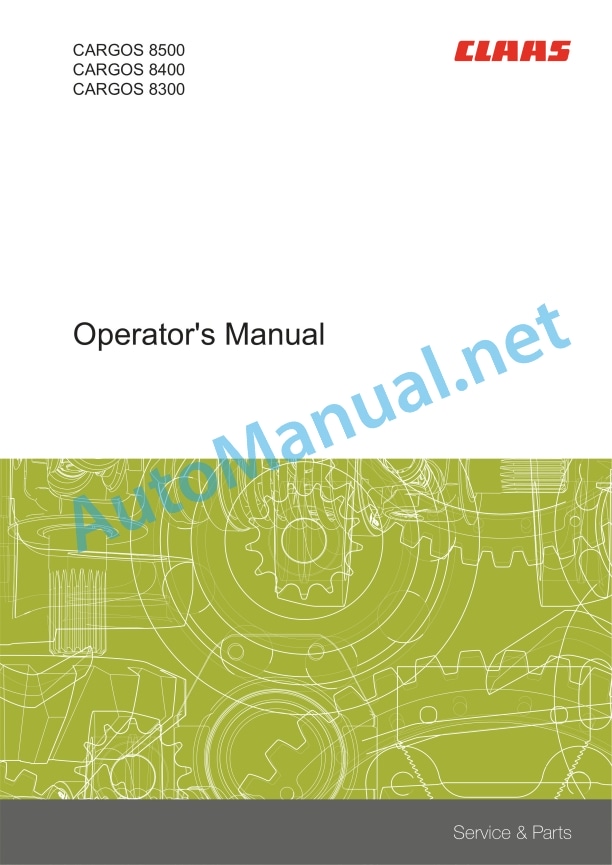Claas Cargos 8500-8300 (991) Loader Wagons Operator Manual EN
$50.00
- Model: Cargos 8500-8300 (991) Loader Wagons
- Type Of Manual: Operator Manual
- Language: EN
- Format: PDF(s)
- Size: 216 MB
File List:
00 0288 014 3.pdf
00 0292 625 4.pdf
00 0292 832 1.pdf
00 0298 486 7.pdf
00 0301 051 0.pdf
00 2348 408 0.pdf
00 2348 427 0.pdf
00 0288 014 3.pdf:
EASY on board app
Table of contents
1 Introduction
1.1 General information
1.1.1 Validity of the manual
1.1.2 Information about this Operator’s Manual
1.1.3 Symbols and notes
1.1.4 Qualified specialist workshop
1.1.5 Maintenance notes
1.1.6 Notes on warranty
1.1.7 Spare parts and technical questions
1.1.8 Technical requirements
1.2 Intended use
1.2.1 Intended use
1.2.2 Reasonably foreseeable misuse
2 Safety
2.1 Identifying warnings
2.1.1 Hazard signs
2.1.2 Signal word
2.2 Safety rules
2.2.1 Meaning of Operator’s Manual
2.2.2 Requirements made on all persons working with the product
2.2.3 Hazard areas
2.2.4 Check interactions with self-propelled machines / tractors and implements
2.2.5 Structural changes
2.2.6 Optional equipment and spare parts
2.2.7 Technical status
2.2.8 Hazard caused by damage to the product
2.2.9 Visibility of work area
2.2.10 Glare and reflections
2.2.11 Unintentional triggering of functions
2.2.12 Hazards caused by signal tones
2.2.13 Unauthorised use
2.2.14 Use of mobile terminal outside the cab
2.2.15 Follow the safety instructions
2.2.16 Respecting technical limit values
2.2.17 Preparing the product for road travel
2.2.18 Hazards when driving on the road and on the field
2.2.19 Hazards when driving on the road with an ISOBUS implement
2.2.20 Switching off the mobile terminal while driving
2.2.21 Hazards from disturbance of WLAN environment
2.2.22 Hazards from covering up the App
2.2.23 Hazards caused by malfunctions of the app
2.2.24 Raised machine parts and loads
3 Product description
3.1 Overview and method of operation
3.1.1 Overview of CWI
3.1.2 Functions of CWI
3.2 Identification plates and identification numbers
3.2.1 CWI identification plate
3.3 Information on the product
3.3.1 Factory settings
3.3.2 Software and hardware version
3.3.3 Seal on the CWI
4 Operating and display elements
4.1 CLAAS Wireless Interface (CWI)
4.1.1 CWI operating elements
4.2 CWI Setup App
4.2.1 Overview of screen
4.2.2 Buttons
4.2.3
4.2.4
4.2.5
5 Technical specifications
5.1 CLAAS Wireless Interface (CWI)
5.1.1 Specification
6 Preparing the product
6.1 Installing the product
6.1.1 Installing the CWI Setup app
6.1.2 Installing the EASY on board app
6.1.3 Connecting the tablet
7 Operation
7.1 Initial operation
7.1.1 Establishing the WLAN connection for the first time
7.1.2 Changing factory settings
7.1.3 Establishing the WLAN connection
7.2 CWI Setup App
7.2.1 Calling up menus
7.2.2 Establishing a secure data connection
7.2.3 Deleting a secure data connection
7.2.4 Displaying the software version
7.3 CWI Setup – Settings
7.3.1 Changing settings
7.3.2 Switching LEDs on and off
7.4 CWI setup – Advanced settings
7.4.1 Deleting the connection partner in CWI
7.4.2 Deleting the connection partner on the tablet
7.4.3 Resetting the CWI to factory settings
7.4.4 Resetting the tablet to factory settings
7.4.5 Switching the CAN filter on and off
7.5 EASY on board App
7.5.1 Launching Operator’s Manual
8 Faults and remedies
8.1 Overview of problems
8.1.1 CWI faults
8.1.2 Fault message: USB charging connection was disconnected
8.1.3 Fault message: Tablet outside WLAN reception area
8.1.4 Fault message: Screen locked
9 Maintenance
9.1 Maintenance schedules
9.1.1 Daily
9.2 Tablet
9.2.1 Cleaning the tablet
9.2.2 Downloading software updates
9.2.3 Updating the operating system
10 Putting out of operation and disposal
10.1 General information
10.1.1 Decommissioning and disposal
11 EC declaration of conformity
11.1 CLAAS Wireless Interface (CWI)
11.1.1 EU Declaration of conformity
12 Technical terms and abbreviations
12.1 Terms and explanations
12.1.1 Abbreviations
12.1.2 Technical terms
00 0292 625 4.pdf:
COMMUNICATOR II
Table of contents
1 Introduction
1.1 Notes on the manual
1.1.1 Validity of manual
1.1.2 Information about this Operator’s Manual
1.1.3 Symbols and notes
1.1.4 Optional equipment
1.1.5 Qualified specialist workshop
1.1.6 Maintenance notes
1.1.7 Notes on warranty
1.1.8 Spare parts and technical questions
1.2 Intended use
1.2.1 Intended use
1.2.2 Reasonably foreseeable misuse
2 Safety
2.1 Identifying warnings
2.1.1 Hazard signs
2.1.2 Signal word
2.2 Safety rules
2.2.1 Meaning of Operator’s Manual
2.2.2 Requirements made on all persons working with the product
2.2.3 Hazard areas
Hazard areas
2.2.4 Interaction between the control terminal and the machine or tractor
2.2.5 Structural changes
2.2.6 Optional equipment and spare parts
2.2.7 Technical status
2.2.8 Danger from damage to the machine
2.2.9 Complying with technical limit values
2.2.10 Preparing the product for road travel
2.2.11 Hazards when driving on the road and in the field
2.2.12 Hazards when driving on the road with an ISOBUS implement
2.2.13 Switching off the terminal while driving
2.2.14 Electrocution by electrical system
2.2.15 Only carry out work on the machine when it is stopped
2.2.16 Maintenance operations and repair work
2.2.17 Raised machine parts and loads
2.2.18 Welding work prohibited
3 Product description
3.1 Overview and method of operation
3.1.1 Overview of COMMUNICATOR II
3.1.2 Function of COMMUNICATOR II
3.2 Identification plates and identification numbers
3.2.1 Identification plate of COMMUNICATOR II
4 Operating and display elements
4.1 COMMUNICATOR II
4.1.1 Terminal
4.1.2 Terminal program
4.2 Universal terminal menu structure (service)
4.2.1 Main menu of universal terminal
4.2.2
4.2.3
4.2.4
4.2.5
4.3 Job processing (task) menu structure
4.3.1 Job processing main menu
4.3.2
4.3.3
4.3.4
4.3.5
4.3.6
5 Technical specifications
5.1 COMMUNICATOR II
5.1.1 Specification
6 Preparing the product
6.1 Switching off and securing the machine
6.1.1 Shut down and secure the machine
7 Operation
7.1 Switching COMMUNICATOR II on/off
7.1.1 Switching COMMUNICATOR II on
7.1.2 Selecting the application
7.1.3 Switching off COMMUNICATOR II
7.2 Programmable keys
7.2.1 Displaying the key assignment
7.2.2 Creating a key assignment
Step 1: Selecting the control and the key
00 0292 832 1.pdf:
OPERATOR
Table of contents
1 To this Operator’s Manual
1.1 Notes on the manual
1.1.1 Validity of the manual
1.1.2 Using the manual
1.1.3 Symbols and notes
1.1.4 Technical specifications
2 Safety
2.1 Safety rules
2.1.1 Particularly important
2.1.2 Intended use
2.1.3 Reasonably foreseeable misuse
2.1.4 General safety and accident prevention regulations
3 Product description
3.1 Overview and method of operation
3.1.1 OPERATOR overview
3.1.2 OPERATOR mode of operation
3.2 Identification plates and identification numbers
3.2.1 Spare parts and technical questions
3.2.2 OPERATOR identification plate
4 Operating and display elements
4.1 CLAAS OPERATOR
4.1.1 Terminal
4.1.2 Terminal program
4.1.3 Menu overview
4.1.4 Information menu
4.1.5 Settings menu
4.1.6 Time menu
4.1.7 Diagnosis menu
4.1.8 Language and units menu
5 Technical specifications
5.1 CLAAS OPERATOR
5.1.1 Specification
6 Operation
6.1 Switching the OPERATOR on and off
6.1.1 Switching on the OPERATOR
6.1.2 Selecting an application
6.1.3 Switching off the OPERATOR
6.2 Terminal settings
6.2.1 Adjusting the screen and volume
Day mode
Night mode
6.2.2 Adjusting the date and time
6.2.3 Displaying the diagnosis information
On-board voltage display (1)
Enabling the speed signal (2)
Displaying the CLAAS ISOBUS ECU address and name (3)
6.2.4 Setting the language and display formats
Setting the language
Setting the display formats
7 Maintenance
7.1 Maintenance
7.1.1 Daily
8 Putting out of operation and disposal
8.1 General information
8.1.1 Putting out of operation and disposal
9 Technical terms and abbreviations
9.1 Terms and explanations
9.1.1 Technical words
9.1.2 Abbreviations
00 0298 486 7.pdf:
CARGOS 8500CARGOS 8400CARGOS 8300
Table of contents
1 Introduction
1.1 General information
1.1.1 Validity of the manual
1.1.2 Information about this Operator’s Manual
1.1.3 Symbols and notes
1.1.4 Optional equipment
1.1.5 Qualified specialist workshop
1.1.6 Maintenance notes
1.1.7 Notes on warranty
1.1.8 Spare parts and technical questions
1.2 Intended use
1.2.1 Intended use
1.2.2 Reasonably foreseeable misuse
2 Safety
2.1 Identifying warnings
2.1.1 Hazard signs
2.1.2 Signal word
2.2 Safety rules
2.2.1 Importance of Operator’s Manual
2.2.2 Observe the safety decals and warnings
2.2.3 Requirements for all persons working with the machine
2.2.4 Children in danger
2.2.5 Hazard areas
2.2.6 Presence between tractor and machine
2.2.7 Persons riding on the machine
2.2.8 Hitching the tractor to the machine
2.2.9 Danger of injury from rotating shafts
2.2.10 Structural changes
2.2.11 Optional equipment and spare parts
2.2.12 Controlling the tractor when it is running
2.2.13 Operation only after proper putting into operation
2.2.14 Technical condition
2.2.15 Danger from damage to the machine
2.2.16 Complying with technical limit values
2.2.17 Danger from continued running of machine parts
2.2.18 Keeping the safety devices functional
2.2.19 Personal protective equipment
2.2.20 Wearing suitable clothing
2.2.21 Removing dirt and loose objects
2.2.22 Preparing the machine for road travel
2.2.23 Risks when driving on the road and in the field
2.2.24 Parking the machine safely
2.2.25 Unsupervised parking
2.2.26 Unsuitable operating utilities
2.2.27 Safe handling of operating and auxiliary utilities
2.2.28 Environmental protection and disposal
2.2.29 Fire prevention
2.2.30 Lethal electrocution from overhead lines
2.2.31 Electrocution by electrical system
2.2.32 Pressurised fluids
2.2.33 Compressed air
2.2.34 Hot surfaces
2.2.35 Working on machine only after shutting it down
2.2.36 Maintenance work and repairs
2.2.37 Raised machine parts and loads
2.2.38 Danger from welding work
2.3 Safety marking
2.3.1 Layout of safety decals
2.3.2 Safety decals on the machine
3 Machine description
3.1 Overview and method of operation
3.1.1 Overview of machine with tridem axle assembly
3.1.2 Overview of machine with tandem axle assembly
3.1.3 How the machine works (self-loading forage wagon)
3.1.4 How the machine works (transport wagon)
3.1.5 Function of articulated drawbar
Hitched machine
Unhitched machine
3.2 Safety devices
3.2.1 Parking brake
3.2.2 Stand
3.2.3 Wheel chocks
3.3 Optional equipment
3.3.1 CEMIS 700*
3.3.2 EASY on board App*
Requirements made on the tablet (not included in the shipping package)
3.3.3 TELEMATICS ON IMPLEMENT*
3.3.4 TIM SPEED CONTROL*
3.3.5 ISOBUS connecting cable*
3.3.6 Extension cable*
3.3.7 Hydraulic coupling as per ISO 16028*
3.3.8 Slip yoke*
3.3.9 Tail section* with removed proportioning rollers
3.3.10 Loading unit transport frame*
3.3.11 Hydraulic roof panel*
3.3.12 Additional pick-up touch wheel*
3.3.13 Fill level sensor*
3.3.14 Filling level display*
3.3.15 LED work lights*
3.3.16 Side marker lights*
3.3.17 External load weight display*
3.3.18 Loading space cover*
3.3.19 Channel cover*
3.3.20 Hydraulic pick-up load relief*
3.3.21 PROFI CAM 3*
3.3.22 Battery cable*
3.3.23 ISOBUS battery cable*
3.3.24 Order printer* for ISOBUS
3.3.25 Loading and torque gauge pin*
3.3.26 Load weight display*
3.3.27 Torque-controlled unloading*
3.3.28 Automatic articulated drawbar control*
3.3.29 Electronic-hydraulic forced steering system*
3.4 Identification plates and vehicle identification number
3.4.1 Machine identification plate
3.4.2 Machine identification plate
3.4.3 Identification plate of the drawbar
3.4.4 Identification plate of the axles
3.4.5 Identification plate of compressed air brake
3.5 Information on the machine
3.5.1 Stickers on the machine
4 Operating and display elements
4.1 Controls
4.1.1 External control panel
4.1.2 Hydro-pneumatic chassis ball valves*
Driving height
Suspension
4.2 Display elements
4.2.1 Pressure gauge of the pick-up load relief*
4.2.2 PROFI CAM 3* monitor
4.3 Menu structure of terminal
4.3.1 Display variants
4.3.2 Display overview
4.3.3 Overview of
4.3.4
Description of soft keys in
Description of symbols in the data field
4.3.5
Description of soft keys in
Description of symbols in the data field
4.3.6
Description of soft keys in the
Description of symbols in the data field
Description of symbols in the
4.3.7
Description of soft keys in
Description of symbols in the data field
4.3.8
Description of soft keys in
Description of symbols in the data field
4.3.9 Settings menu
Description of soft keys in
Description of symbols in the data field
4.3.10
Description of soft keys in
Description of symbols in the
Description of symbols in the
4.3.11
Description of soft keys in
Description of symbols in the
4.3.12
Description of soft keys in
Description of symbols in the
4.3.13
Description of soft keys in
Description of symbols in the
4.3.14
Description of soft keys in
Description of symbols in the
4.3.15
Description of soft keys in
Description of symbols in the
4.3.16
Description of soft keys in
Description of symbols in the data field
4.3.17 Status bar
Description of
5 Technical specifications
5.1 CARGOS 8500
5.1.1 Dimensions
5.1.2 Loading space cover dimensions*
5.1.3 Dimensions of platform gate raiser*
5.1.4 Weights
Tridem axle assembly* 30 t
Tridem axle assembly* 27 t
Tandem axle assembly* 20 t
Tandem axle assembly* 18 t
5.1.5 Pick-up
5.1.6 Cutterbar
5.1.7 Tyre pressure
5.1.8 Requirements of the tractor
5.1.9 Electric system
5.1.10 PTO speed
5.1.11 Sound pressure level
5.2 CARGOS 8400
5.2.1 Dimensions
5.2.2 Loading space cover dimensions*
5.2.3 Dimensions of platform gate raiser*
5.2.4 Weights
Tandem axle assembly* 20 t
Tandem axle assembly* 18 t
5.2.5 Pick-up
5.2.6 Cutterbar
5.2.7 Tyre pressure
5.2.8 Requirements of the tractor
5.2.9 Electric system
5.2.10 PTO speed
5.2.11 Sound pressure level
5.3 CARGOS 8300
5.3.1 Dimensions
5.3.2 Loading space cover dimensions*
5.3.3 Dimensions of platform gate raiser*
5.3.4 Weights
Tandem axle assembly* 18 t
5.3.5 Pick-up
5.3.6 Cutterbar
5.3.7 Tyre pressure
5.3.8 Requirements of the tractor
5.3.9 Electric system
5.3.10 PTO speed
5.3.11 Sound pressure level
5.4 Operating utilities
5.4.1 Lubricants
6 Machine preparation
6.1 Switching off and securing the machine
6.1.1 Switching off and securing the tractor and machine
6.2 Assembling the machine
6.2.1 Fitting the universal drive shaft to the machine
6.2.2 Connecting the ISOBUS connecting cable*
6.2.3 Sliding the wheel chocks into their brackets
6.3 Accessing workplaces and maintenance spaces
6.3.1 Accessing the loading space
6.3.2 Leaving the loading space
6.3.3 Front covers
Opening the front covers
Closing the front covers
6.3.4 Rear left covers
Opening the rear left covers
Closing the rear left covers
6.4 Adapting the tractor
6.4.1 Checking the protective guard on the tractor PTO shaft
6.4.2 Tractor hitching for Cuna F3 hitch eye
6.4.3 Tractor hitching for electronic-hydraulic forced steering*
6.4.4 Configuring the tractor air brake system
6.4.5 Installing the COMMUNICATOR II*
6.4.6 Installing the OPERATOR*
6.5 Using the tractor terminal
6.5.1 Using the tractor terminal
6.5.2 Tractor terminal and joystick
6.5.3 Using the COMMUNICATOR II* and joystick
6.5.4 Converting the FENDT Vario tractor terminal
6.6 Adapting the machine
6.6.1 Checking the universal drive shaft length
Shortest working position of the universal drive shaft
Longest working position of the universal drive shaft
6.6.2 Adapting the universal drive shaft length
6.6.3 Adapting the hydraulic system
Closed hydraulic system (constant-pressure or load sensing)
Open hydraulic system (standard system)
6.6.4 Adjusting the articulated drawbar
Adjusting the left-hand piston rod
Adjusting the right-hand piston rod
6.6.5 Adjusting the chassis height*
Raising the chassis on the right
Raising the chassis on the left
Lowering the chassis on the right
Lowering the chassis on the left
6.6.6 Relocating the drawbar sensor* lever
6.6.7 Adjusting the electronic-hydraulic forced steering system*
Check basic setup
Adjusting the tow bar
Avoiding overstretching the sensor
6.6.8 Adjusting the cutting trough with central adjustment*
Opening the cutting frame completely
Adjusting the working position / moving the cutting frame to the blockage position
Locking the cutting frame
6.6.9 Adjusting the working height of the pick-up
6.6.10 Adjusting the pick-up load relief*
6.6.11 Setting the baffle plate
6.6.12 Removing and installing the loading and cutting unit
6.6.13 Removing the proportioning roller unit*
6.7 Hitching the machine
6.7.1 Connecting the lighting
6.7.2 Connecting CEMIS 700*
6.7.3 Connecting COMMUNICATOR II*
6.7.4 Connecting the OPERATOR*
6.7.5 Connecting the tablet*
6.7.6 Connecting the ISOBUS battery cable*
6.7.7 Connecting the ISOBUS battery cable*
6.7.8 Connecting the ISOBUS battery cable*
6.7.9 Connecting the hydraulic hose lines
Connecting the hydraulic hoses with the hydraulic system closed (with load sensing)
Connecting the hydraulic hoses with the hydraulic system open (without load sensing)
Connecting hydraulic hose P1
6.7.10 Connecting the hydraulic hoses of the loading space cover*
6.7.11 Remove safety lock*
6.7.12 Hitching the articulated drawbar
6.7.13 Raising the stand
6.7.14 Coupling the electronic-hydraulic forced steering system*
6.7.15 Installing the universal drive shaft
6.7.16 Connecting the compressed air brake*
6.7.17 Connecting the hydraulic brake*
6.7.18 Connecting the breakaway brake*
6.7.19 Removing the wheel chocks
6.7.20 Releasing the parking brake
6.8 Unhitching the machine
6.8.1 Applying the parking brake
6.8.2 Positioning the wheel chock at the wheel
6.8.3 Swinging down the jack stand
6.8.4 Removing the universal drive shaft
6.8.5 Unhitching the articulated drawbar
6.8.6 Unhitching the electronic-hydraulic forced steering system*
6.8.7 Fit safety lock*
6.8.8 Disconnecting the hydraulic lines from the tractor
6.8.9 Disconnect the hydraulic hose lines of the loading bay cover* from the tractor
6.8.10 Disconnecting the hydraulic brake* from the tractor
6.8.11 Disconnecting the breakaway brake*
6.8.12 Disconnecting the compressed air brake*
6.8.13 Disconnecting the lighting
6.8.14 Disconnecting CEMIS 700*
6.8.15 Disconnecting the COMMUNICATOR II*
6.8.16 Disconnecting the OPERATOR*
6.8.17 Disconnecting the tablet*
6.9 Prepare road travel
6.9.1 Move machine to transport position
6.9.2 Activating the suspension of the hydro-pneumatic chassis*
6.10 Preparing fieldwork
6.10.1 Deactivating the suspension of the hydro-pneumatic chassis*
6.11 Loading the machine
6.11.1 Manoeuvring the machine
6.11.2 Loading and lashing down the machine
7 Operation
7.1 ISOBUS and OPERATOR control unit
7.1.1 Description
7.2 CEMIS 700
7.2.1 CEMIS 700* recommendations
7.2.2 CEMIS 700* operation
7.2.3 Calling up the menu
7.2.4 Calling up the sub-menu
7.3 COMMUNICATOR II
7.3.1 COMMUNICATOR II* recommendations
7.3.2 Operating the COMMUNICATOR II*
7.3.3 Calling up the menu
7.3.4 Calling up the sub-menu
7.4 OPERATOR
7.4.1 OPERATOR* recommendations
7.4.2 Operating the OPERATOR*
7.5 EASY on board App
7.5.1 EASY on board App* recommendations
7.5.2 Operation of the EASY on board App*
7.5.3 Calling up the menu
7.5.4 Calling up the sub-menu
7.6 Fieldwork settings
7.6.1 Switching on the terminal
7.6.2 Starting the control program
7.6.3 Creating a job
7.6.4 Switching data entry on and off
7.6.5 Activating TIM SPEED CONTROL*
7.6.6 Setting the TIM SPEED CONTROL* ground speed
Setting the working speed
Setting the headland speed
7.6.7 Switching torque-controlled loading* on and off
7.6.8 Changing the floor conveyor speed for loading
7.6.9 Changing the loading pressure exerted by roof panel*
7.6.10 Switching the ensiling agent feed* on and off
7.6.11 Switching the automatic blockage removal* on and off
7.6.12 Adjusting the automatic unladen weight measurement
7.6.13 Switching torque-controlled unloading* on and off
7.6.14 Changing the floor conveyor speed for unloading
7.6.15 Changing the opening angle of the tailgate
7.6.16 Activating and deactivating automatic residue emptying mode
7.6.17 Changing the time between two lubrication intervals*
7.6.18 Changing the steered trailing axle settings
Adjusting the speed-dependent axle lock
Setting the silo mode
7.6.19 Changing the settings for the electronic-hydraulic forced steering system*
Setting the silo mode
Adjusting the adaptive articulation angle warning
Saving the end stops of the adaptive articulation angle warning
Adjusting the dynamic steering line shift
7.6.20 Displaying and changing the articulated drawbar positions
Changing the default value of the articulated drawbar
7.6.21 Switching the automatic articulated drawbar control* on and off
7.6.22 Reversing the floor conveyor drive
7.6.23 Switching on the work lights
Switching on the work lights individually
7.6.24 Switching off the work lights
Switching off the lights individually
7.6.25 Lifting the lift axle*
7.6.26 Lowering the lift axle*
7.6.27 Operating the electro-hydraulic forced steering system* manually
Activating the offset mode
Activating the axle lock mode
7.6.28 Using further functions of electronic-hydraulic forced steering system*
Road mode
Axle lock mode
Offset mode
Manual mode
7.6.29 Locking the steered trailing axle
7.6.30 Unlocking the steered trailing axle
7.6.31 Switching the external load weight display* on and off
7.6.32 Restoring the factory settings
7.6.33 Reloading the control programme
7.7 Using the
7.7.1 Available functions
7.7.2 Application example of COMMUNICATOR II*
7.7.3 Application example of AXION / ARION
7.7.4 Application examples of FENDT
7.8 Driving on the road
7.8.1 Driving on public roads
7.9 Fieldwork
7.9.1 Observe the following during field work
7.10 Operating the loading bay cover
7.10.1 Opening the loading space covers*
7.11 Loading the machine automatically
7.11.1 Activating automatic loading
Calling up via the
Calling up via the
7.11.2 Engaging the PTO shaft
7.11.3 Loading without knives
7.11.4 Activating automatic articulated drawbar control*
7.11.5 Switching the floor conveyor drive on and off
Switching on the floor conveyor drive
Switching off the floor conveyor drive
Adjusting the threshold value
Adjusting the loading pressure*
7.11.6 Switching on the floor conveyor briefly
7.11.7 Raising to the headland position
7.11.8 Lowering to working position
7.11.9 Checking the loading process
7.11.10 Finishing automatic loading
7.11.11 Starting TIM SPEED CONTROL*
On the headland
7.11.12 Adapting TIM SPEED CONTROL* control system to forage conditions
7.11.13 Finishing TIM SPEED CONTROL*
Exiting via the control unit
Exiting when pick-up is blocked
7.12 Unloading the machine automatically
7.12.1 Activating automatic unloading
Calling up via the
Calling up via the
7.12.2 Torque-controlled unloading*
Switching the floor conveyor drive on and off automatically
7.12.3 Switching the floor conveyor drive on and off
Switching on the floor conveyor drive
Switching off the floor conveyor drive
7.12.4 Changing the floor conveyor speed
Entering a value in the entry field
Changing the speed by means of keys
7.12.5 Automatic residue emptying of machine
Engaging automatic residue emptying
Disengaging automatic residue emptying
7.12.6 Manual residue emptying of machine
Raising the swivelling floor conveyor
Lowering the swivelling floor conveyor
7.12.7 Finishing automatic unloading
7.12.8 Starting manual unladen weight measurement
7.13 Moving the machine to transport position automatically
7.13.1 Activating the transport position after loading
7.13.2 Activating the transport position after unloading
7.14 Loading the machine manually
7.14.1 Opening the roof panel* for loading from the front (for the chopping start)
7.14.2 Closing the roof panel*
7.14.3 Moving the machine to the loading position
7.14.4 Lower the pick-up
7.14.5 Switching on the pick-up drive
7.14.6 Engaging the PTO shaft
7.14.7 Switching on the floor conveyor drive
7.14.8 Switching off the floor conveyor drive
7.14.9 Raising to the headland position manually
Lowering to working position
7.14.10 Disengaging the PTO shaft
7.14.11 Switching off the pick-up drive
7.15 Unloading the machine manually
7.15.1 Moving the machine to the unloading position
7.15.2 Engaging the proportioning rollers*
7.15.3 Opening the tailgate
7.15.4 Switching on the floor conveyor drive
7.15.5 Changing the floor conveyor speed
7.15.6 Disengaging the proportioning roller*
7.15.7 Closing the tailgate
7.15.8 Switching off the floor conveyor drive
7.15.9 Starting manual unladen weight measurement
7.16 Moving the machine to transport position manually
7.16.1 Closing the roof panel*
7.16.2 Closing the loading space covers*
7.16.3 Moving the articulated drawbar to the transport position
7.16.4 Activating hydraulic drawbar suspension*
7.17 Finishing fieldwork
7.17.1 Displaying and printing job data
Order-dependent counters
Non-order-dependent counter
Printing the job data*
7.17.2 Switching off the terminal
7.18 Initialising
7.18.1 Applications
7.18.2 Learning the articulated drawbar end stops
7.18.3 Learning the roof panel* end stops
7.18.4 Learning the tailgate end stops
7.18.5 Initialising torque-controlled unloading*
Fault during initialisation of torque-controlled unloading
7.18.6 Learning the pick-up end stops
Faults while learning the pick-up position:
7.18.7 Learning the cutting trough end stops
7.18.8 Learning the end stops of
John Deere Repair Technical Manual PDF
John Deere Repair Technical Manual PDF
John Deere Repair Technical Manual PDF
John Deere Repair Technical Manual PDF
John Deere 18-Speed PST Repair Manual Component Technical Manual CTM168 10DEC07
New Holland Service Manual PDF
John Deere Repair Technical Manual PDF
John Deere Repair Technical Manual PDF
John Deere Parts Catalog PDF
John Deere Harvesters 8500 and 8700 Parts Catalog CPCQ24910 Spanish
John Deere Repair Technical Manual PDF
John Deere Diesel Engines PowerTech 4.5L and 6.8L – Motor Base Technical Manual 07MAY08 Portuguese



























